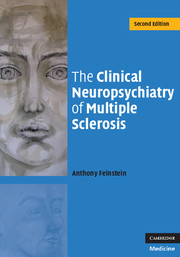Book contents
- Frontmatter
- Contents
- Acknowledgement
- Foreword
- 1 Multiple sclerosis: diagnosis and definitions
- 2 Depression: prevalence, symptoms, diagnosis and clinical correlates
- 3 Depression: etiology and treatment
- 4 Multiple sclerosis, bipolar affective disorder and euphoria
- 5 Multiple sclerosis and pseudobulbar affect
- 6 Multiple sclerosis and psychosis
- 7 Cognitive impairment in multiple sclerosis
- 8 The natural history of cognitive change in multiple sclerosis
- 9 Cognitive impairment in multiple sclerosis: detection, management and significance
- 10 Neuroimaging correlates of cognitive dysfunction
- 11 Multiple sclerosis, disease-modifying treatments and behavioral change
- 12 Multiple sclerosis: a subcortical, white matter dementia?
- Index
- Plate section
- References
4 - Multiple sclerosis, bipolar affective disorder and euphoria
Published online by Cambridge University Press: 13 August 2009
- Frontmatter
- Contents
- Acknowledgement
- Foreword
- 1 Multiple sclerosis: diagnosis and definitions
- 2 Depression: prevalence, symptoms, diagnosis and clinical correlates
- 3 Depression: etiology and treatment
- 4 Multiple sclerosis, bipolar affective disorder and euphoria
- 5 Multiple sclerosis and pseudobulbar affect
- 6 Multiple sclerosis and psychosis
- 7 Cognitive impairment in multiple sclerosis
- 8 The natural history of cognitive change in multiple sclerosis
- 9 Cognitive impairment in multiple sclerosis: detection, management and significance
- 10 Neuroimaging correlates of cognitive dysfunction
- 11 Multiple sclerosis, disease-modifying treatments and behavioral change
- 12 Multiple sclerosis: a subcortical, white matter dementia?
- Index
- Plate section
- References
Summary
Occasionally, it has been my experience to encounter an MS patient with mania, who apart from the abnormal mental state examination is neurologically quite well. Furthermore, I have treated patients with manic episodes heralding the onset of MS and have also come across bipolar patients who subsequently went on to develop MS often years later. Managing the floridly manic MS patient can present a considerable challenge given the potential that neuroleptic and mood-stabilizing medications have in further compromising neurological function. Early detection of the patient going “high” makes management easier, but as a first step to early detection, increased awareness amongst clinicians of the increased rate of co-morbidity is needed. Criteria for diagnosing mania are clearly set out and, as with clinically significant depression, diagnosis and treatment, particularly of patients with mildly elevated mood, does not have to await the arrival of the neuropsychiatrist.
Conceptual and semantic issues
Mania may occur as part of many physical conditions or as a reaction to drug therapy. When this occurs, the mania has been termed “secondary,” differentiating it from the more usual occurrence as a primary psychiatric syndrome. The correct DSM-IV (American Psychiatric Association, 1994) terminology for the syndrome is a “mood disorder due to a general medical condition” (MDGMC) (Table 4.1), with the type of mood change specified as “with manic features” (Table 4.2) or “with hypomanic features” (Table 4.3). If the symptoms of mania are present together with depression and neither predominates, the type of mood change is specified as “mixed.”
- Type
- Chapter
- Information
- The Clinical Neuropsychiatry of Multiple Sclerosis , pp. 66 - 81Publisher: Cambridge University PressPrint publication year: 2007



